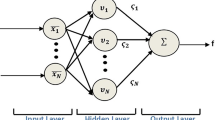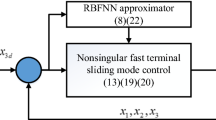Abstract
This paper describes an impedance controller that uses the fast terminal sliding mode and adaptive neural networks. The proposed controller improves the dynamic trajectory performance and force tracking accuracy of robotic manipulators in three-dimensional uncertain environments. The key idea of the controller is that the improved adaptive nonsingular fast terminal sliding mode (ANFTSMC) uses integral control to eliminates chattering without affecting the tracking performance. Also, adaptive neural networks are introduced into the sliding mode controller to provide a local approximation in the dynamic model of the robotic manipulator, and the stability is guaranteed through the Lyapunov theory. Finally, combined with impedance control, the operation of the robotic manipulator is simulated in environments containing various obstacle types, and experimental validation has demonstrated the effectiveness and superiority of the proposed control scheme.












Similar content being viewed by others
References
Hogan, N. (1984). Impedance control: An approach to manipulation. In 1984 American control conference, pp. 304–313. IEEE.
Raibert, M. H., & Craig, J. (1981). Hybrid position/force control of manipulators. Journal of Dynamic Systems Measurement and Control-transactions of The Asme, 103(2), 126–133.
Komati, B., Pac, M. R., Ranatunga, I., Clévy, C., Popa, D. O., & Lutz, P. (2013). Explicit force control vs impedance control for micromanipulation. In ASME 2013 International Design Engineering Technical Conferences and Computers and Information in Engineering Conference. American Society of Mechanical Engineers Digital Collection.
Mokhtari, M., Taghizadeh, M., & Mazare, M. (2021). Impedance control based on optimal adaptive high order super twisting sliding mode for a 7-dof lower limb exoskeleton. Meccanica, 56(3), 535–548.
Cao, H., Chen, X., He, Y., & Zhao, X. (2019). Dynamic adaptive hybrid impedance control for dynamic contact force tracking in uncertain environments. IEEE Access, 7, 83162–83174.
Yang, Z., Peng, J., & Liu, Y. (2019). Adaptive neural network force tracking impedance control for uncertain robotic manipulator based on nonlinear velocity observer. Neurocomputing, 331, 263–280.
Wang, W., Li, Q., Chenghua, L., Jinlin, G., Li, A., Li, Y., et al. (2021). Impedance estimation for robot contact with uncalibrated environments. Mechanical Systems and Signal Processing, 159, 107819.
Aghaeinezhad, S. M., Taghizadeh, M., Mazare, M., & Kazemi, M. G. (2021). Individual pitch angle control of a variable speed wind turbine using adaptive fractional order non-singular fast terminal sliding mode control. International Journal of Precision Engineering and Manufacturing, 1–12.
Wang, T., & Chellai, R. (2018). A novel adaptive control of a human musculoskeletal arm model. Computers and Electrical Engineering, 69, 732–739.
Zhan, L., & Zhou, K. (2013). Adaptive fuzzy sliding mode control for a robotic aircraft flexible tooling system. The International Journal of Advanced Manufacturing Technology, 69(5), 1469–1481.
Hu, Y., Su, H., Fu, J., Karimi, H. R., de Ferrigno, G., Momi, E., & Knoll, A. (2020). Nonlinear model predictive control for mobile medical robot using neural optimization. IEEE Transactions on Industrial Electronics, 1, 1–10.
Slotine, J.-J., & Sastry, S. S. (1983). Tracking control of non-linear systems using sliding surfaces, with application to robot manipulators. International Journal of Control, 38(2), 465–492.
Zhao, N., & Zhu, J. (2020). Sliding mode control for robust consensus of general linear uncertain multi-agent systems. International Journal of Control Automation and Systems.
Tran, D.-T., Truong, H. V. A., & Ahn, K. K. (2021). Adaptive nonsingular fast terminal sliding mode control of robotic manipulator based neural network approach. International Journal of Precision Engineering and Manufacturing, 22(3), 417–429.
Sai, H., Xu, Z., He, S., Zhang, E., & Zhu, L. (2021). Adaptive nonsingular fixed-time sliding mode control for uncertain robotic manipulators under actuator saturation. Isa Transactions.
Wang, Y., Gao, Y., Karimi, H. R., Shen, H., & Fang, Z. (2017). Sliding mode control of fuzzy singularly perturbed systems with application to electric circuit. IEEE Transactions on Systems, Man, and Cybernetics: Systems, 48(10), 1667–1675.
Yuqiang, W., Xinghuo, Y., & Man, Z. (1998). Terminal sliding mode control design for uncertain dynamic systems. Systems and Control Letters, 34(5), 281–287.
Zhihong, M., Paplinski, A. P., & Wu, H. R. (1994). A robust mimo terminal sliding mode control scheme for rigid robotic manipulators. IEEE Transactions on Automatic Control, 39(12), 2464–2469.
Xinghuo, Y., & Zhihong, M. (2002). Fast terminal sliding-mode control design for nonlinear dynamical systems. IEEE Transactions on Circuits and Systems I: Fundamental Theory and Applications, 49(2), 261–264.
Feng, Y., Xinghuo, Y., & Man, Z. (2002). Non-singular terminal sliding mode control of rigid manipulators. Automatica, 38(12), 2159–2167.
Yang, L., & Yang, J. (2011). Nonsingular fast terminal sliding-mode control for nonlinear dynamical systems. International Journal of Robust and Nonlinear Control, 21(16), 1865–1879.
Ghaf-Ghanbari, P., Mazare, M., & Taghizadeh, M. (2021). Active fault-tolerant control of a schonflies parallel manipulator based on time delay estimation. Robotica, 39(8), 1518–1535.
Mazare, M., Taghizadeh, M., & Ghaf-Ghanbari, P. (2020). Fault-tolerant control based on adaptive super-twisting nonsingular integral-type terminal sliding mode for a delta parallel robot. Journal of The Brazilian Society of Mechanical Sciences and Engineering, 42(8), 1–15.
Neila, M. B. R., & Tarak, D. (2011). Adaptive terminal sliding mode control for rigid robotic manipulators. International Journal of Automation and Computing, 8(2), 215–220.
Boukattaya, Mohamed, Mezghani, Neila, & Damak, Tarak. (2018). Adaptive nonsingular fast terminal sliding-mode control for the tracking problem of uncertain dynamical systems. ISA Transactions, 77, 1–19.
Yi, S., & Zhai, J. (2019). Adaptive second-order fast nonsingular terminal sliding mode control for robotic manipulators. ISA Transactions, 90, 41–51.
Narendra, K. S., & Mukhopadhyay, S. (1993). Adaptive control of nonlinear multivariable systems using neural networks. In Proceedings of 32nd IEEE Conference on Decision and Control, pp. 3066–3071. IEEE.
Jin, L., Li, S., Jiguo, Y., & He, J. (2018). Robot manipulator control using neural networks: A survey. Neurocomputing, 285, 23–34.
Wang, L., Chai, T., & Zhai, L. (2009). Neural-network-based terminal sliding-mode control of robotic manipulators including actuator dynamics. IEEE Transactions on Industrial Electronics, 56(9), 3296–3304.
Yen, V. T., Nan, W. Y., & van Cuong, P. (2019). Recurrent fuzzy wavelet neural networks based on robust adaptive sliding mode control for industrial robot manipulators. Neural Computing and Applications, 31(11), 6945–6958.
Wang, Fei, Chao, Zhi-qiang, Huang, Lian-bing, Li, Hua-ying, & Zhang, Chuan-qing. (2019). Trajectory tracking control of robot manipulator based on RBF neural network and fuzzy sliding mode. Cluster Computing, 22(3), 5799–5809.
Rani, K., & Kumar, N. (2019). Intelligent controller for hybrid force and position control of robot manipulators using RBF neural network. International Journal of Dynamics and Control, 7(2), 767–775.
Ge, S. S., & Wang, C. (2004). Adaptive neural control of uncertain mimo nonlinear systems. IEEE Transactions on Neural Networks, 15(3), 674–692.
Li, P., Ma, J., & Zheng, Z. (2016). Robust adaptive sliding mode control for uncertain nonlinear mimo system with guaranteed steady state tracking error bounds. Journal of The Franklin Institute-engineering and Applied Mathematics, 353(2), 303–321.
Ge, S. S., Hang, C. C., & Woon, L. C. (1997). Adaptive neural network control of robot manipulators in task space. IEEE Transactions on Industrial Electronics, 44(6), 746–752.
Averta, G., & Hogan, N.. (2020). Enhancing robot-environment physical interaction via optimal impedance profiles. In 2020 8th IEEE RAS/EMBS International Conference for Biomedical Robotics and Biomechatronics (BioRob), pp. 973–980.
Huang, H., Yang, C., & Chen, C. P. (2021). Optimal robot-environment interaction under broad fuzzy neural adaptive control. IEEE Transactions on Systems, Man, and Cybernetics, 51(7), 3824–3835.
Xinbo, Y., Li, Y., Zhang, S., Xue, C., & Wang, Y. (2020). Estimation of human impedance and motion intention for constrained human-robot interaction. Neurocomputing, 390, 268–279.
He, W., Dong, Y., & Sun, C. (2016). Adaptive neural impedance control of a robotic manipulator with input saturation. IEEE Transactions on Systems, Man, and Cybernetics: Systems, 46(3), 334–344.
Salehi, M., & Vossoughi, G. (2008). Impedance control of flexible base mobile manipulator using singular perturbation method and sliding mode control law. International Journal of Control Automation and Systems, 6(5), 677–688.
Funding
This work is partially supported by the National Natural Science Foundation of China (11972343, 91848202), the Funded and Supported by National Key R&D Program of China (No.2016YFE0205000).
Author information
Authors and Affiliations
Corresponding author
Ethics declarations
Conflicts of interest
The authors declare that they have no conflict of interest.
Additional information
Publisher's Note
Springer Nature remains neutral with regard to jurisdictional claims in published maps and institutional affiliations.
Rights and permissions
About this article
Cite this article
Sai, H., Xu, Z., Li, Y. et al. Adaptive Nonsingular Fast Terminal Sliding Mode Impedance Control for Uncertainty Robotic Manipulators. Int. J. Precis. Eng. Manuf. 22, 1947–1961 (2021). https://doi.org/10.1007/s12541-021-00589-9
Received:
Revised:
Accepted:
Published:
Issue Date:
DOI: https://doi.org/10.1007/s12541-021-00589-9




